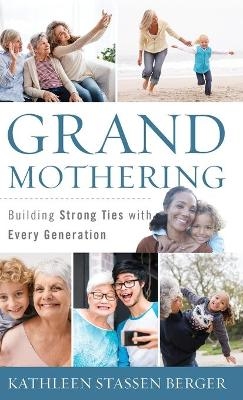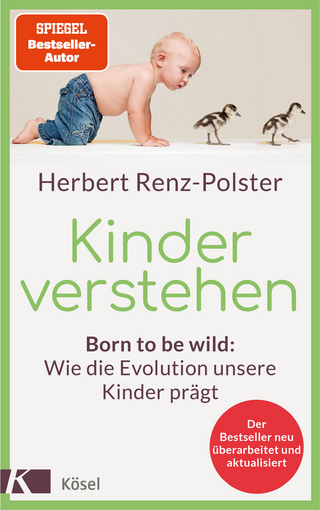
Grandmothering
Rowman & Littlefield (Verlag)
978-1-5381-3313-2 (ISBN)
Contemporary grandmothers are often marginalized from extended family life because social institutions and grandmothers themselves do not understand that they could be vital for working parents, for overactive children, for suicidal youth, indeed for many of the problems of modern grandchildren.
The genetics and hormones of older women have designed them to be vital family members, with patience and perspective that come with age and experience. In addition, biology helps directly via menopause. The grandmother hypothesis explains that human women, unlike almost any other living creature, experience decades of life after menopause, in order to make grandmothers available to their descendants.
Here, Kathleen Berger explores he role of grandmothers in the lives of their grandchildren. She uses real life examples to illustrate how grandmothers can best integrate themselves into the lives of their children’s families without overstepping. She explores the particular needs of each stage of childhood as they relate to grandmother involvement and input. Before a child is born, grandmothers need to attend to building a strong relationship with the future parents. In infancy, attachment and feeding are crucial. In early childhood, grandmothers need to follow the parent’s lead, remembering that a parental alliance is essential. In childhood, children need to be safe but not isolated, and both bullies and victims benefit from a grandmother’s support and assistance. In adolescence and emerging adulthood, grandmothers need to build direct connections and not avoid the difficult topics of sex, drugs, death, disease, and money. Throughout, elders need to learn technology, insuring that it fosters, not impedes relationships.
Problems in relationships are explained honestly and with insight. Among these are issues when three generations share a home, when parents get divorced, and when grandchildren rebel against parental authority. Throughout the work, both the joy and the complications of effective grandmothering are described. Whether you’re a biological grandmother, a trusted step-grandmother, or just a warm and trusted older woman with young ones in your life, you can be a vital force in the lives of future generations.
Kathleen Stassen Berger is a professor at Bronx Community College, City University of New York, where she has taught psychology for forty years. She is the author of the leading textbooks in human development, used by college students in all 50 states, 12 nations, in five languages. She is also the mother of four and the grandmother of three.
Contents
Preface
Dedication
Part I: Get up from the Floor
Chapter One: Excluded and on the Floor
What is Wrong?
Cohort and Culture
Grandmothers and Families
Chapter Two: Why Grandmothers?
The Paradox of Menopause
Evidence for Grandmother Hypothesis
Still True?
Chapter Three: Deep Within, On the Floor Again
Every Part of the brain
Genes, Selfish and Not
Oxytocin and Other Hormones
Chapter Four: Too Little Grandmothering
Some Care is Essential
Who is to Blame
Suing for Visitation Rights
Chapter Five: Too Much Grandmothering
Custodial Grandmothers
Three Generation Households
Finding the Balance
Part II: At every Age
Chapter Six: The Loving Couple
Lesson One: Keep Comments to Yourself
Lesson Two: Respect the Gatekeepers
Lesson Three: Recognize Linked Lives
Chapter Seven: The Pregnant Couple
Lesson Four: Quiet Fears and Anxieties
Lesson Five: Learn about Innovations
Lesson Six: Build Relationships Carefully
Chapter Eight: Birth and the Newborn
Lesson Seven: Remember the other people.
Lesson Eight: Recognize Birth as a Pivot
Lesson Nine: Prevent Postpartum Depression
Chapter Nine: Infants
Lesson Ten: Notice and Admire
Lesson Eleven: Avoid Attachment Wars
Lesson Twelve: Don’t Feed the Baby, Unless….
Chapter Ten: Young Children
Lesson Thirteen: Twelve: Avoid Assumptions
Lesson Fourteen: Accept Blame and Mediation
Lesson Fifteen: Discipline with Care
Chapter Eleven: School Children
Lesson Sixteen: Keep them Safe and Social
Lesson Seventeen: Protect Victims and Bullies
Lesson Eighteen: Help with Education
Chapter Twelve: Divorce and Grandchildren
Lesson Nineteen: Strengthen the Partnership
Lesson Twenty: Be a Steady Anchor
Lesson Twenty-One: Step into the Family
Chapter Thirteen: Adolescents
Lesson Twenty-Two: Navigate Changing Relationships
Lesson Twenty-Three: Reconsider Suicide, Drugs, and Sex
Lesson Twenty-Four: Learn Technology
Chapter Fourteen: Emerging Adults
Lesson Twenty-Five: Don’t Advise Settling Down
Lesson Twenty-Six: Explore Values with Words and Money
Lesson Twenty-Seven: Take Care of Health and Ability
Into the Future
References
Bibliography
Index
About the Author
| Erscheinungsdatum | 02.11.2019 |
|---|---|
| Verlagsort | Lanham, MD |
| Sprache | englisch |
| Maße | 142 x 226 mm |
| Gewicht | 485 g |
| Themenwelt | Sachbuch/Ratgeber ► Gesundheit / Leben / Psychologie ► Familie / Erziehung |
| ISBN-10 | 1-5381-3313-X / 153813313X |
| ISBN-13 | 978-1-5381-3313-2 / 9781538133132 |
| Zustand | Neuware |
| Haben Sie eine Frage zum Produkt? |
aus dem Bereich


